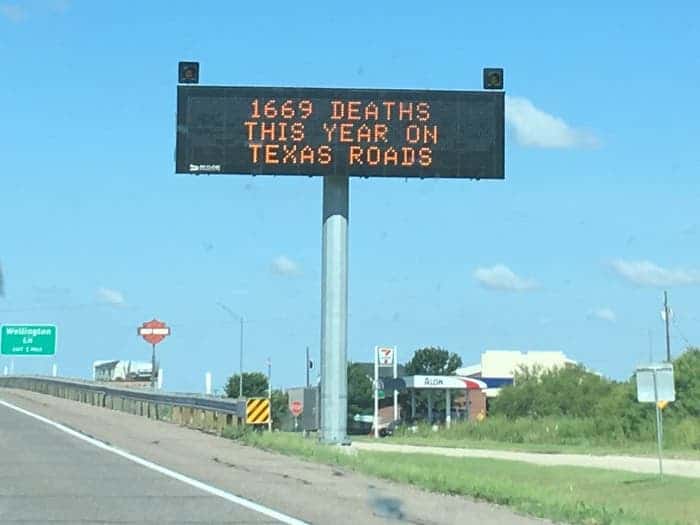
While zooming through busy highways, drivers are sometimes flooded with a myriad of different roadside signs, such as speed limit signs, directions to prominent landmarks, and safety warnings. But concerningly, a new study finds that at least some roadside safety warning signs can backfire and lead to an increase, rather than a decrease, in fatal accidents.
The Texas study
Like many states in the US, Texas displays dynamic warning signs on huge digital billboards indicating the number of recent traffic fatalities, such as “1669 DEATHS THIS YEAR ON TEXAS ROADS.” But unlike other states, Texas shows this sign only once a week every month, which provides the opportunity to compare the evolution of traffic accidents between two distinct groups of drivers — those who are exposed to the sign and those who aren’t. In most other states, these dynamic message signs are more or less random, following an unpredictable pattern. It’s not clear why the Texas Department of Transportation chose this schedule, but researchers couldn’t be more grateful as it provides an ideal natural experiment setting.
Joshua Madsen, an accounting professor at the University of Minnesota, and Jonathan Hall, now an economist at the University of Toronto, Canada, aggregated data from Texas’ nearly 900 dynamic message signs and then started analyzing traffic-related accidents following exposure to such messages.
When the results finally started to roll in, the researchers were simply stunned. Not only did these signs not work, but they were also associated with an increased crash rate of about 4.5% in the next 10 kilometers downstream from the message board.
That’s 2,600 more accidents and 16 more deaths each year in Texas, with an estimated annual socioeconomic cost of $377 million, the study found. Another way to look at it is the result is comparable to raising the speed limit by 3 to 5 miles per hour (4.8 to 8 km/h) or reducing highway troopers by up to 14 percent.
The underlying assumption on everybody’s mind is that these sorts of sobering messages are supposed to make people more alert to their surroundings and therefore help them drive more carefully. What then can explain the findings?
There was no way to arrive at a clear explanation from the way this study was designed, but the authors have some ideas.
They believe messages relaying traffic fatalities certainly grab drivers’ attention but not in the way authorities hope for. Instead, these salient warnings may cause people to question their mortality, sinking into a sort of mini-existential crisis. The end result is that they become extremely distracted by their pestering thoughts, thereby increasing the risk of an accident and perhaps even making insurance so expensive.
Another explanation is that some people may indeed get the right message that they need to drive more safely, but eventually end up doing more harm than good through poor overcompensation, such as braking more strongly than they normally would when another vehicle is in front of them. Or perhaps this is just another case of information overload and on some highways, these signs among dozens of other warning signs may have been just enough to overwhelm the driver.
Madsen is, however, steadfast that fear of death is the prime reason that likely causes the uptick in traffic accidents. His dataset shows that as the number of traffic deaths stated on the displays increases (the counter resets to zero at the beginning of each year), so does the risk of accidents downstream from the signs in a perfect linear relationship. “The bigger the number displayed, the more crashes that will occur in that month,” he says. A larger fatality number on the warning sign is more frightening so it is more likely that people start thinking about their fragile existence and what would happen to their loved ones if they were to share the same fate as
It’s highly challenging to get to the bottom of this and perhaps the only way to reveal the mechanism in action is to study the brain waves of volunteers as they use as a vehicle simulator while encountering the morbid road signs. But if there’s one important takeaway is that even seemingly good ideas can backfire disastrously. People parse information all the time, and the lesson is that authorities need to be very careful about what messages they choose to present.
The findings appeared in the journal Science.


